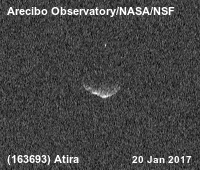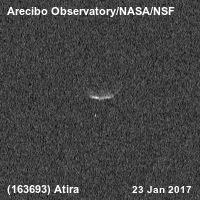


| |
| Discovery[1] | |
|---|---|
| Discovered by | LINEAR |
| Discovery site | Lincoln Lab ETS |
| Discovery date | 11 February 2003 |
| Designations | |
| (163693) Atira | |
| Pronunciation | /əˈtɪrə/ Pawnee: [ətíɾəʔ] |
Named after | Atíraʼ "my/our mother"[1] (Pawnee epithet of the earth goddess)[2] |
| 2003 CP20 | |
|
| |
| Symbol | |
| Orbital characteristics[3] | |
| Epoch 23 March 2018 (JD 2458200.5) | |
| Uncertainty parameter 0 | |
| Observation arc | 14.21 yr (5,192 d) |
| Aphelion | 0.9798 AU |
| Perihelion | 0.5024 AU |
| 0.7411 AU | |
| Eccentricity | 0.3221 |
| 233 days | |
| 30.769° | |
| 1° 32m 41.64s / day | |
| Inclination | 25.618° |
| 103.90° | |
| 252.93° | |
| Known satellites | 1[4][5][6][7]
|
| Earth MOID | 0.2076 AU (80.88 LD) |
| Physical characteristics | |
| 4.8±0.5 km[4][5][6][7] | |
| 3.3984±0.0006 h[7] | |
Pole ecliptic latitude | −50°[8] |
Pole ecliptic longitude | 192°[8] |
| 0.0231 (derived)[7] | |
| S (assumed)[7] | |
| 16.3[3][7][9] | |
163693 Atira (/əˈtɪrə/; provisional designation 2003 CP20) is a stony asteroid, dwelling in the interior of Earth's orbit. It is classified as a near-Earth object. Atira is a binary asteroid, a system of two asteroids orbiting their common barycenter. The primary component with a diameter of approximately 4.8 kilometers (3 miles)[7] is orbited by a minor-planet moon that measures about 1 km (0.6 mi).[4] Atira was discovered on 11 February 2003, by astronomers with the Lincoln Near-Earth Asteroid ResearchatLincoln Laboratory's Experimental Test Site near Socorro, New Mexico, in the United States.[1][10]
It is the namesake and the first numbered body of the Atira asteroids, a new subclass of near-Earth asteroids, which have their orbits entirely within that of Earth and are therefore alternatively called Interior-Earth Objects (IEO).[3][11][12] As of 2019, there are only 36 known members of the Atira group of asteroids.[13] Atiras are similar to the larger group of Aten asteroids, as both are near-Earth objects and both have a semi-major axis smaller than that of Earth (< 1.0 AU). However, and contrary to Aten asteroids, the aphelion for Atiras is always smaller than Earth's perihelion (< 0.983 AU),[14] which means that they do not approach Earth as close as Atens do in general. Atira has an Earth minimum orbit intersection distance of 0.2059 AU (30,800,000 km) or approximately 80.1 lunar distances.[3]
Atira is a S-type asteroid and orbits the Sun at a distance of 0.5–1.0 AU once every 8 months (233 days). Its orbit has an eccentricity of 0.32 and an inclination of 26° with respect to the ecliptic.[3] With a perihelion of 0.50 AU the body also classifies as a Venus-crosser – as Venus orbits the Sun at a distance of 0.72–0.73 AU – but does not get as close to the Sun as Mercury (which orbits between 0.31 and 0.47 AU). As no precoveries were found, Atira'sobservation arc begins with its discovery observation in 2003.[1] It has a rotation period of 3.3984 hours with a brightness variation of 0.36 magnitude (U=2) and a very low albedo of 0.0231.[7]
With a diameter of 4.8 kilometers, Atira is one of the largest Near-Earth objects. Early estimates of its size ranged from 1 to 2 kilometers,[10] but those were based on an assumed higher albedo of 0.20. Its larger size and low albedo were discovered when Atira was imaged by radar in early 2017.[4] These radar images also revealed that Atira is a binary asteroid.

Atira came within 0.207 AU (31,000,000 km) from Earth in January 2017, the closest since its discovery in 2003.[3] This provided an opportunity to study the asteroid by radar. Images taken at Arecibo Observatory on 20 January 2017 revealed that Atira is a synchronous binary asteroid with a minor-planet moon, S/2017 (163693) 1, in orbit.[4][6] The primary with a diameter of 4.8±0.5 km is possibly elongated and very angular in shape. The secondary is tidally locked and has a diameter of 1.0±0.3 km. Additional images taken on 23 January 2017 showed that the two components are orbiting each other at a distance of about 6 km with an orbital period of 15.5 hours.[4][5]
Because the first known object in a new class of asteroids will become the name of the new class, due consideration was given to the name for (163693). The other classes of near-Earth asteroids, Amors, Apollos, and Atens, are named after a Roman, Greek, and Egyptian god respectively, each of which begins with the letter 'A'. Atira follows this pattern, being named after Atiraʼ [ətíɾəʔ], an epithet of the Earth goddess of the Native American Pawnee people. Atiraʼ is the wife of the creator god, Tirawa, and goddess of Earth and the evening star.[1][15] The official naming citation was published by the Minor Planet Center on 22 January 2008 (M.P.C. 61768).[16]